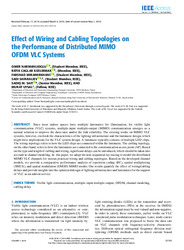Effect of wiring and cabling topologies on the performance of distributed MIMO OFDM VLC systems
| dc.contributor.author | Narmanlıoğlu, Ömer | |
| dc.contributor.author | Kızılırmak, R. Ç. | |
| dc.contributor.author | Miramirkhani, Farshad | |
| dc.contributor.author | Safaraliev, Sadi | |
| dc.contributor.author | Sait, S. M. | |
| dc.contributor.author | Uysal, Murat | |
| dc.date.accessioned | 2020-08-30T12:54:43Z | |
| dc.date.available | 2020-08-30T12:54:43Z | |
| dc.date.issued | 2019 | |
| dc.identifier.issn | 2169-3536 | en_US |
| dc.identifier.uri | http://hdl.handle.net/10679/6862 | |
| dc.identifier.uri | https://ieeexplore.ieee.org/document/8698786 | |
| dc.description.abstract | Since most indoor spaces have multiple luminaires for illumination, for visible light communication (VLC) systems, multiple-input multiple-output (MIMO) communication emerges as a natural solution to improve the data rates and/or the link reliability. The existing works on MIMO VLC systems, however, overlook the characteristics of the lighting infrastructure and the luminaire design, which might have implications for the VLC system design. A luminaire typically consists of multiple LED chips. The wiring topology refers to how the LED chips are connected within the luminaire. The cabling topology, on the other hand, refers to how the luminaires are connected to the communication access point (AP). Based on the type and length of cabling and wiring, significant delays can be introduced, which should be taken into account in channel modeling. In this paper, we adopt the non-sequential ray tracing to model the distributed MIMO VLC channels for various practical wiring and cabling topologies. Based on the developed channel models, we provide a comparative performance analysis of repetition coding (RC), spatial multiplexing (SMUX), and spatial modulation (SMOD) MIMO modes. Our results quantify the effect of wiring/cabling delays and provide insights into the optimized design of lighting infrastructure and luminaires for the support of VLC as an add-on service. | en_US |
| dc.description.sponsorship | Nazarbayev University ; King Fahd University of Petroleum and Minerals, Dhahran, Saudi Arabia ; TÜBİTAK | |
| dc.language.iso | eng | en_US |
| dc.publisher | IEEE | en_US |
| dc.relation.ispartof | IEEE Access | |
| dc.rights | openAccess | |
| dc.title | Effect of wiring and cabling topologies on the performance of distributed MIMO OFDM VLC systems | en_US |
| dc.type | Article | en_US |
| dc.peerreviewed | yes | en_US |
| dc.publicationstatus | Published | en_US |
| dc.contributor.department | Özyeğin University | |
| dc.contributor.authorID | (ORCID 0000-0001-5945-0813 & YÖK ID 124615) Uysal, Murat | |
| dc.contributor.ozuauthor | Uysal, Murat | |
| dc.identifier.volume | 7 | en_US |
| dc.identifier.startpage | 52743 | en_US |
| dc.identifier.endpage | 52754 | en_US |
| dc.identifier.wos | WOS:000466963000001 | |
| dc.identifier.doi | 10.1109/ACCESS.2019.2903726 | en_US |
| dc.subject.keywords | Visible light communication | en_US |
| dc.subject.keywords | Multiple-input multiple-output | en_US |
| dc.subject.keywords | OFDM | en_US |
| dc.subject.keywords | Channel modeling | en_US |
| dc.subject.keywords | Cabling delay | en_US |
| dc.contributor.ozugradstudent | Narmanlıoğlu, Ömer | |
| dc.contributor.ozugradstudent | Miramirkhani, Farshad | |
| dc.contributor.ozugradstudent | Safaraliev, Sadi | |
| dc.contributor.authorMale | 4 | |
| dc.relation.publicationcategory | Article - International Refereed Journal - Institution Academic Staff and PhD Student |
Files in this item
This item appears in the following Collection(s)
Share this page



